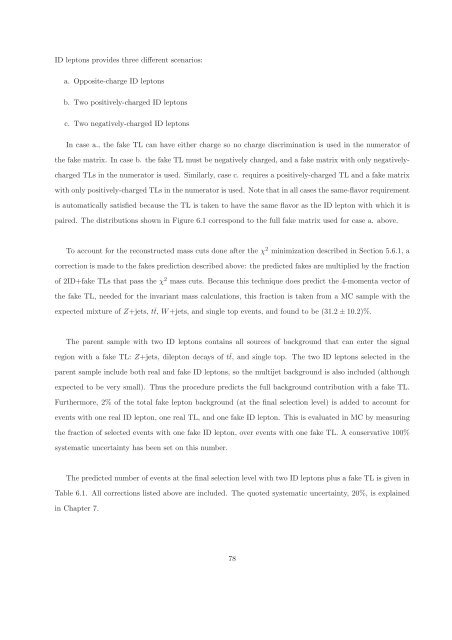CERN-THESIS-2012-153 26/07/2012 - CERN Document Server
CERN-THESIS-2012-153 26/07/2012 - CERN Document Server
CERN-THESIS-2012-153 26/07/2012 - CERN Document Server
Create successful ePaper yourself
Turn your PDF publications into a flip-book with our unique Google optimized e-Paper software.
ID leptons provides three different scenarios:<br />
a. Opposite-charge ID leptons<br />
b. Two positively-charged ID leptons<br />
c. Two negatively-charged ID leptons<br />
In case a., the fake TL can have either charge so no charge discrimination is used in the numerator of<br />
the fake matrix. In case b. the fake TL must be negatively charged, and a fake matrix with only negatively-<br />
charged TLs in the numerator is used. Similarly, case c. requires a positively-charged TL and a fake matrix<br />
with only positively-charged TLs in the numerator is used. Note that in all cases the same-flavor requirement<br />
is automatically satisfied because the TL is taken to have the same flavor as the ID lepton with which it is<br />
paired. The distributions shown in Figure 6.1 correspond to the full fake matrix used for case a. above.<br />
To account for the reconstructed mass cuts done after the χ 2 minimization described in Section 5.6.1, a<br />
correction is made to the fakes prediction described above: the predicted fakes are multiplied by the fraction<br />
of 2ID+fake TLs that pass the χ 2 mass cuts. Because this technique does predict the 4-momenta vector of<br />
the fake TL, needed for the invariant mass calculations, this fraction is taken from a MC sample with the<br />
expected mixture of Z+jets, t¯t, W+jets, and single top events, and found to be (31.2 ± 10.2)%.<br />
The parent sample with two ID leptons contains all sources of background that can enter the signal<br />
region with a fake TL: Z+jets, dilepton decays of t¯t, and single top. The two ID leptons selected in the<br />
parent sample include both real and fake ID leptons, so the multijet background is also included (although<br />
expected to be very small). Thus the procedure predicts the full background contribution with a fake TL.<br />
Furthermore, 2% of the total fake lepton background (at the final selection level) is added to account for<br />
events with one real ID lepton, one real TL, and one fake ID lepton. This is evaluated in MC by measuring<br />
the fraction of selected events with one fake ID lepton, over events with one fake TL. A conservative 100%<br />
systematic uncertainty has been set on this number.<br />
The predicted number of events at the final selection level with two ID leptons plus a fake TL is given in<br />
Table 6.1. All corrections listed above are included. The quoted systematic uncertainty, 20%, is explained<br />
in Chapter 7.<br />
78















